Ecological Management and Land Rehabilitation in Mining Areas from the Perspective of Actor-Network Theory—A Case Study of Lizuizi Coal Mine in China
Abstract
1. Introduction
2. Literature Review and Theoretical Framework
2.1. Research Related to Ecological Environment Management in Mining Areas
2.2. Actor-Network Theory and Analysis Framework
3. Selected Case and Data Sources
3.1. Selected Case
3.2. Data Sources
4. Case Study: Actor Network in Ecological Restoration Management
4.1. Actor Identification and the Problem Statement
4.2. Interest Satisfaction and Mobilization by Enrolment
4.3. Actor Potential Disagreement and Dissipation
5. Benefits after Ecological Restoration of L Coal Mine
- (1)
- Social benefits
- (2)
- Economic benefits
- (3)
- Ecological benefits
6. Discussion and Policy Suggestion
6.1. Discussion
6.2. Policy Suggestion
- (1)
- Further improve the legal system
- (2)
- Building a governance system with multiple subjects and collaborative participation
- (3)
- To reasonably resettle residents in subsidence areas and pay attention to their mental health
7. Conclusions
Author Contributions
Funding
Institutional Review Board Statement
Informed Consent Statement
Data Availability Statement
Conflicts of Interest
References
- Yudovich, Y.E.; Ketris, M.P. Mercury in coal: A review Part 2. Coal use and environmental problems. Int. J. Coal Geol. 2005, 62, 135–165. [Google Scholar] [CrossRef]
- Bian, Z.; Inyang, H.I.; Daniels, J.L.; Otto, F.; Struthers, S. Environmental issues from coal mining and their solutions. Min. Sci. Technol. 2010, 20, 215–223. [Google Scholar] [CrossRef]
- Bian, Z.; Dong, J.; Lei, S.; Leng, H.; Mu, S.; Wang, H. The impact of disposal and treatment of coal mining wastes on environment and farmland. Environ. Geol. 2009, 58, 625–634. [Google Scholar] [CrossRef]
- Luo, M.; Bai, Z.; Liu, X. Survey and Evaluation of Land Reclamation Potential; China Agricultural Science and Technology Press: Beijing, China, 2013; ISBN 978-7-5116-0761-4. [Google Scholar]
- Zhou, Y.; Zhou, X.; Yang, C. Concerns about the market-based approach to promote ecological restoration of mines. China Land 2020, 3, 42–45. [Google Scholar] [CrossRef]
- Yuan, L.; Jiang, Y.; Wang, K.; Zhao, Y.; Hao, X.; Xu, C. Scientific considerations on the precise exploitation of resources in closed/abandoned mines in China. J. China Coal Soc. 2018, 43, 14–20. [Google Scholar]
- Ismaeel, W.S.E.; Ali, A.A.M. Assessment of eco-rehabilitation plans: Case study ‘Richordi Berchet’ palace. J. Clean. Prod. 2020, 259, 120857. [Google Scholar] [CrossRef]
- Montrie, C. To Save the Land and People: A History of Opposition to Surface Coal Mining in Appalachia; University of North Carolina Press: Chapel Hill, NC, USA, 2003; ISBN 0-8078-5435-2. [Google Scholar]
- Luo, M.; Yu, Z.; Ying, L. Integrated land management from a perspective of ecosystem health. China Land 2020, 2, 4–8. [Google Scholar] [CrossRef]
- Available online: http://nrcs.rancher.usda.gov/ (accessed on 23 October 2022).
- Xi, J. The Governance of China. III/Xi Jinping; Foreign Languages Press: Beijing, China, 2020; ISBN 9787119124117. [Google Scholar]
- Liu, X.; Wang, X. A research review on the application of actor network theory in the field of human geography. Prog. Geogr. 2013, 32, 1139–1147. [Google Scholar]
- Wang, P.; Wang, R. Actor network theory and commodification in rural space: A case study of Mayufang village in Beijing. Acta Geogr. Sin. 2017, 72, 1408–1418. [Google Scholar]
- Chen, Y.; Yang, R.; Wang, M. Development process of rural homestay tourism and spatial restructuring with the actor-network method from the perspective of shared economy: A case study of Guanhu Village in Shenzhen. Prog. Geogr. 2018, 31, 718–730. [Google Scholar]
- Yang, R.; Xu, Q.; Zhou, J.; Chen, Y. Mechanism of rural space transformation in fengjian acient village of shunde district, foshan based on the actor network. Sci. Geogr. Sin. 2018, 38, 1817–1827. [Google Scholar] [CrossRef]
- Zhang, Y.; Chen, C.; Yi, Q.; Pan, Y.; Bu, Z. Impact of land use change in Huainan coalmine area on regional landscape pattern. J. Earth Environ. 2019, 10, 503–513. [Google Scholar]
- Xu, J.; Li, G.; Yu, J.; Zhao, H.; Yin, P.; Hu, W. Effects of coal exploitation on land use and landscape pattern change in coal mining area. Trans. Chin. Soc. Agric. Eng. 2017, 33, 252–258. [Google Scholar]
- Schroeter, L.; Gläβer, C. Analyses and monitoring of lignite mining lakes in eastern germany with spectral signatures of landsat TM satellite data. Int. J. Coal Geol. 2011, 86, 27–39. [Google Scholar] [CrossRef]
- Liu, X. Gauses and countermeasures of ground collapse by coal mining in Huating County, Gansu Province. Chin. J. Geol. Hazard Control. 2007, 8, 77–81. [Google Scholar]
- Li, G.; Zhang, J. Literature review and practical progress of ecological compensation for mineral resources development. J. Nat. Resour. 2021, 36, 525–540. [Google Scholar]
- Chen, S. Index system of Binchang mining area planning environmental impact assessment. Clean Coal Technol. 2014, 20, 93-95+99. [Google Scholar] [CrossRef]
- Zou, C.; Shen, W.; Liu, F. Preliminary research on evaluation index system of mine ecological environment quality. China Min. Mag. 2011, 20, 56-59+68. [Google Scholar]
- Ning, Y.; Xu, M. Discussion on the scientific development concept and the way to optimize the structure of Shanxi coal industry. North. Econ. 2006, 2, 63–64. [Google Scholar]
- Liu, X. Research on grassroots eco-environmental governance. Dr. Grad. Sch. Chin. Acad. Soc. Sci. 2020. [Google Scholar] [CrossRef]
- Zheng, J. A reflexive explanation of cooperative governance: Cooperative significance, mechanism of occurrence, and government guidance. Soc. Sci. Res. 2020, 5, 72–78. [Google Scholar]
- Ge, W. Countermeasures for coal mining geologic subsidence disaster of China. Energy China 2004, 10, 33–36. [Google Scholar]
- Zhao, X. Relationship between social capital and economic growth, environment imapct. China Popul. Resour. Environ. 2010, 20, 68–73. [Google Scholar]
- Jochimsen, M.E.A. Reclamation of colliery mine spoil founded on natural succession. Water Air Soil Pollut. 1996, 91, 99–108. [Google Scholar] [CrossRef]
- Torigoe, H. Life environmentalism: A model developed under environmental degradation. Int. J. Jpn. Sociol. 2014, 23, 21–31. [Google Scholar] [CrossRef]
- Kada, Y. Three paradigms behind river governance in Japan: Modern technicism, nature conservationism and life environmentalism. Int. J. Jpn. Sociol. 2006, 15, 40–54. [Google Scholar] [CrossRef]
- Yang, P. Interpretation of river management in Lake Biwa Basin from the angle of living environmentalism. Water Resour. Prot. 2015, 31, 16–21. [Google Scholar]
- Wang, S.; Zhang, X.; Torokoshi, H. Constructing a sociology of the environment toward the living: An interview with professor hiroyuki torokoshi. J. China Univ. Geosci. 2014, 14, 110–113. [Google Scholar] [CrossRef]
- Kostka, G.; Hobbs, W. Local energy efficiency policy implementation in China: Bridging the gap between national priorities and local interests. China Q. 2012, 211, 765–785. [Google Scholar] [CrossRef]
- Zhu, X. Multiple coordination of ecological governance: A case study of taihu river basin. Reform 2017, 2, 96–107. [Google Scholar]
- Xi, J. The Governance of China. IV/Xi Jinping; Foreign Languages Press: Beijing, China, 2022; ISBN 978-7-119-13095-8. [Google Scholar]
- Pretty, J. Social capital and the collective management of resources. Science 2003, 302, 1912–1914. [Google Scholar] [CrossRef]
- Latour, B. Science in Action: How to Follow Scientists and Engineers Through Society; Harvard University Press: Cambridge, MA, USA, 1987; ISBN 978-0-674-79291-3. [Google Scholar]
- Callon, M. Some elements of a sociology of translation: Domestication of the scallops and the fishermen of st brieuc bay. Sociol. Rev. 1984, 32, 196–233. [Google Scholar] [CrossRef]
- Law, J. Notes on the theory of the actor-network: Ordering, strategy, and heterogeneity. Syst. Pract. 1992, 5, 379–393. [Google Scholar] [CrossRef]
- Pels, D. The politics of symmetry. Soc. Stud. Sci. 1996, 26, 277–304. [Google Scholar] [CrossRef]
- de Sociologie de L’Innovation Bruno Latour, C.; Latour, B.; Porter, C. Politics of Nature: How to Bring the Sciences Into Democracy; Harvard University Press: Cambridge, MA, USA, 2004; ISBN 978-0-674-01289-9. [Google Scholar]
- Callon, M. The Sociology of an actor-network: The case of the electric vehicle. In Mapping the Dynamics of Science and Technology: Sociology of Science in the Real World; Callon, M., Law, J., Rip, A., Eds.; Palgrave Macmillan: London, UK, 1986; pp. 19–34. ISBN 978-1-349-07408-2. [Google Scholar]
- Callon, M. Struggles and negotiations to define what is problematic and what is not. In The Social Process of Scientific Investigation; Knorr, K.D., Krohn, R., Whitley, R., Eds.; Springer: Dordrecht, The Netherlands, 1981; pp. 197–219. ISBN 978-94-009-9109-5. [Google Scholar]
- Czarniawska, B. Book review: Bruno latour: Reassembling the social: An introduction to actor-network theory. Organ. Stud. 2006, 27, 1553–1557. [Google Scholar] [CrossRef]
- Felski, R. Comparison and translation: A perspective from actor-network theory. Comp. Lit. Stud. 2016, 53, 747–765. [Google Scholar] [CrossRef]
- Shen, P. Study on benefit distribution in technology transfer from the perspective of ANT. Stud. Dialectics Nat. 2019, 35, 28–33. [Google Scholar]
- Guo, J. Actor-network theory of paris school and analysis of philosophical significance. Stud. Dialectics Nat. 2007, 2, 104–108. [Google Scholar]
- Li, F.; Ding, X.; Sun, J. Ecological environment status and development trend of governance technology of coal mining subsidence area in China. Saf. Coal Mines 2021, 52, 232–239. [Google Scholar] [CrossRef]
- Wu, X. Research on “group politics”: Connotation, function and research outlook. Truth Seek. 2009, 3, 64–69. [Google Scholar]
- Lu, B. Analysis of the operating mechanism of leadership teams in major emergencies: Based on a cross-sectoral synergy perspective. Fujian Trib. 2022, 7, 191–200. [Google Scholar]
- Kostka, G.; Nahm, J. Central–local relations: Recentralization and environmental governance in China. China Q. 2017, 231, 567–582. [Google Scholar] [CrossRef]
- Guo, H.; Shi, B. Study on ecological compensation mechanism of nature reserves. Inq. Into Econ. Issues 2013, 8, 135–142. [Google Scholar]
- Kostka, G.; Zhang, X.; Shin, K. Information, technology, and digitalization in China’s environmental governance. J. Environ. Plan. Manag. 2020, 63, 1–13. [Google Scholar] [CrossRef]
- Yu, M.; Zou, F. Stimulating social vitality: The construction of an activist network in the coordinated governance of water environment in the Yangtze River Delta. Jiangsu Soc. Sci. 2022, 1, 43–51+242. [Google Scholar] [CrossRef]
- Latour, B.; de Sociologie de l’Innovation Bruno LaTour, C. Reassembling the Social: An Introduction to Actor-Network-Theory; ACLS Humanities E-Book; OUP Oxford: Oxford, UK, 2005; ISBN 978-0-19-925604-4. [Google Scholar]
- Pawson, H.; Herath, S. Dissecting and tracking socio-spatial disadvantage in urban Australia. Cities 2015, 44, 73–85. [Google Scholar] [CrossRef]



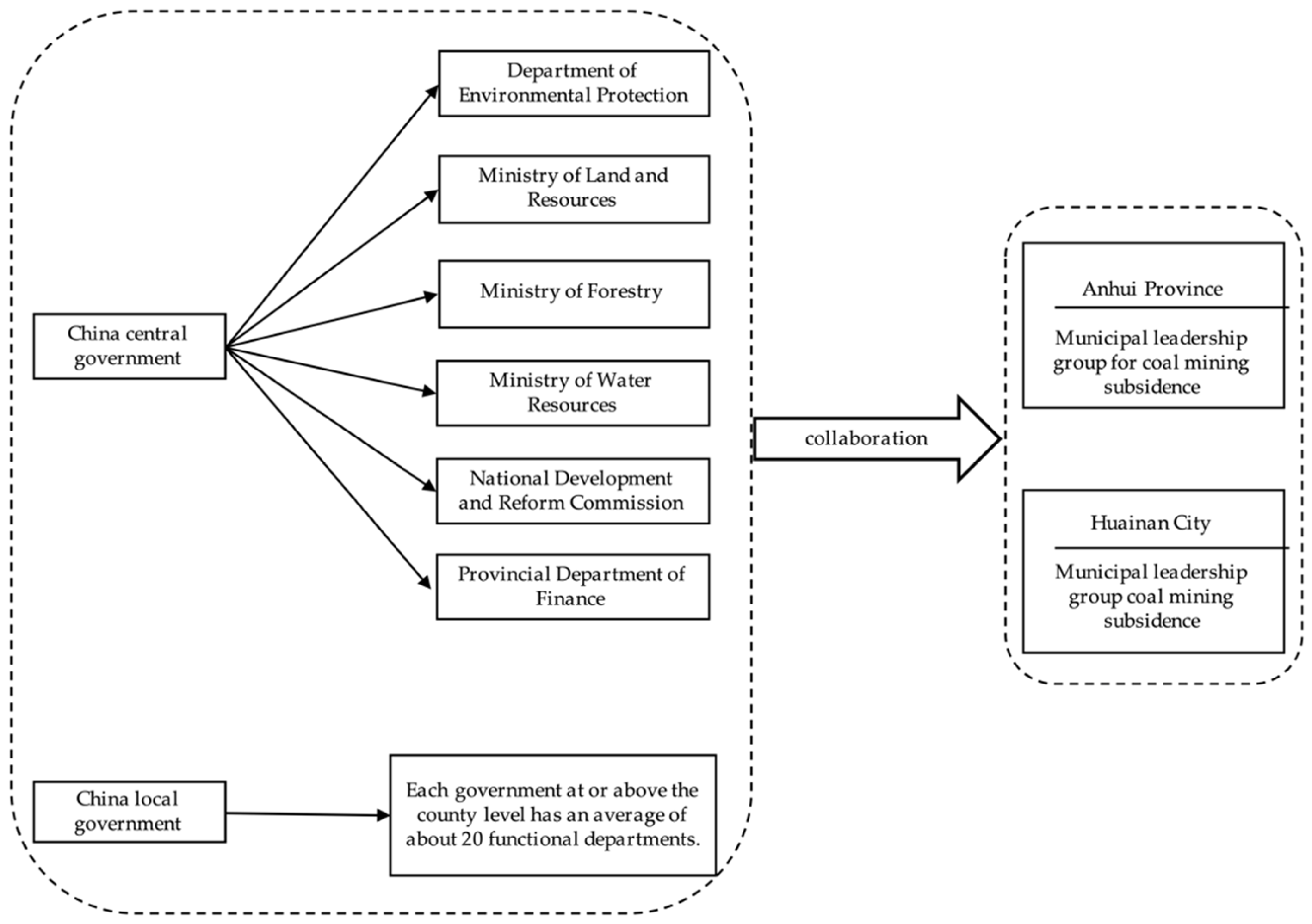

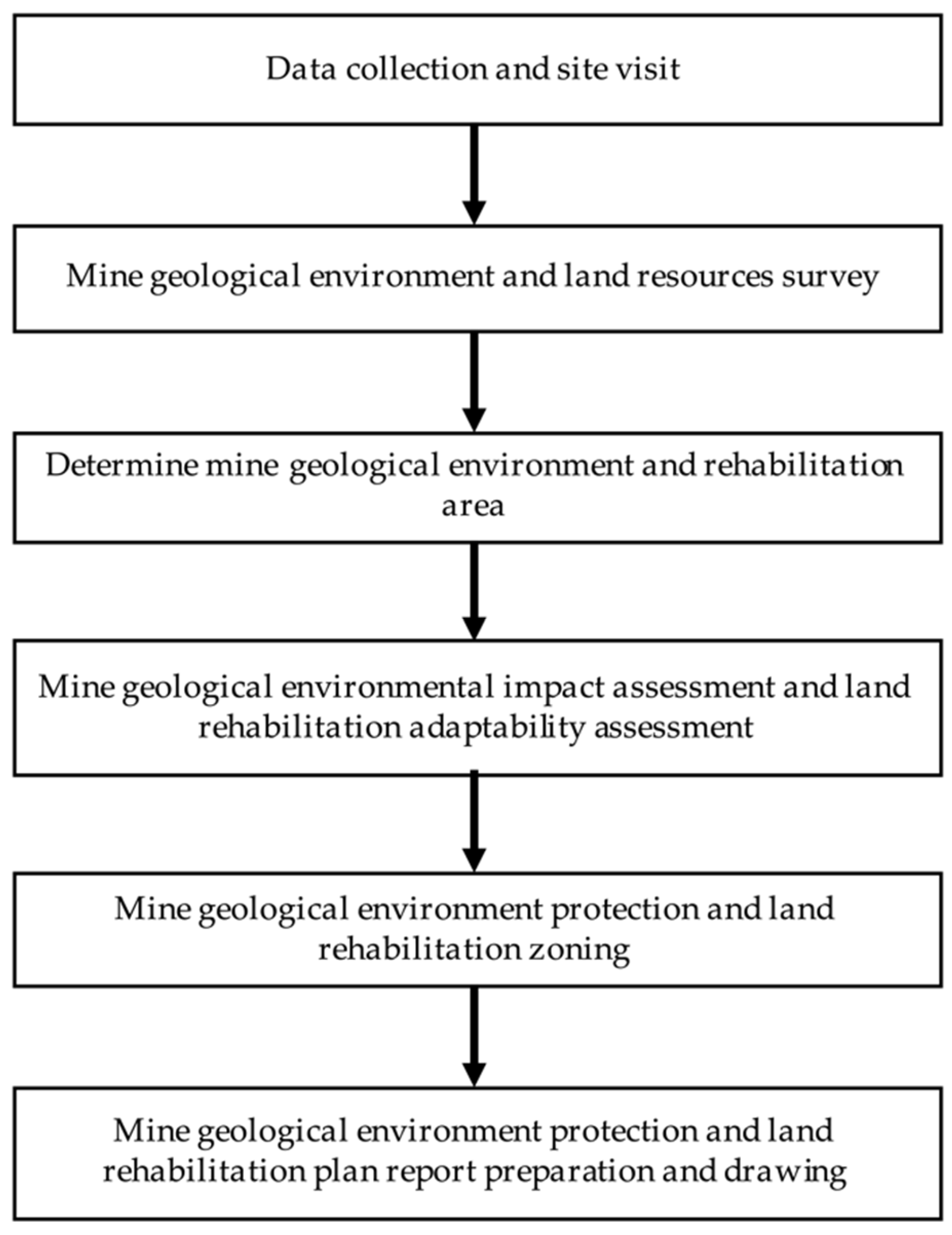
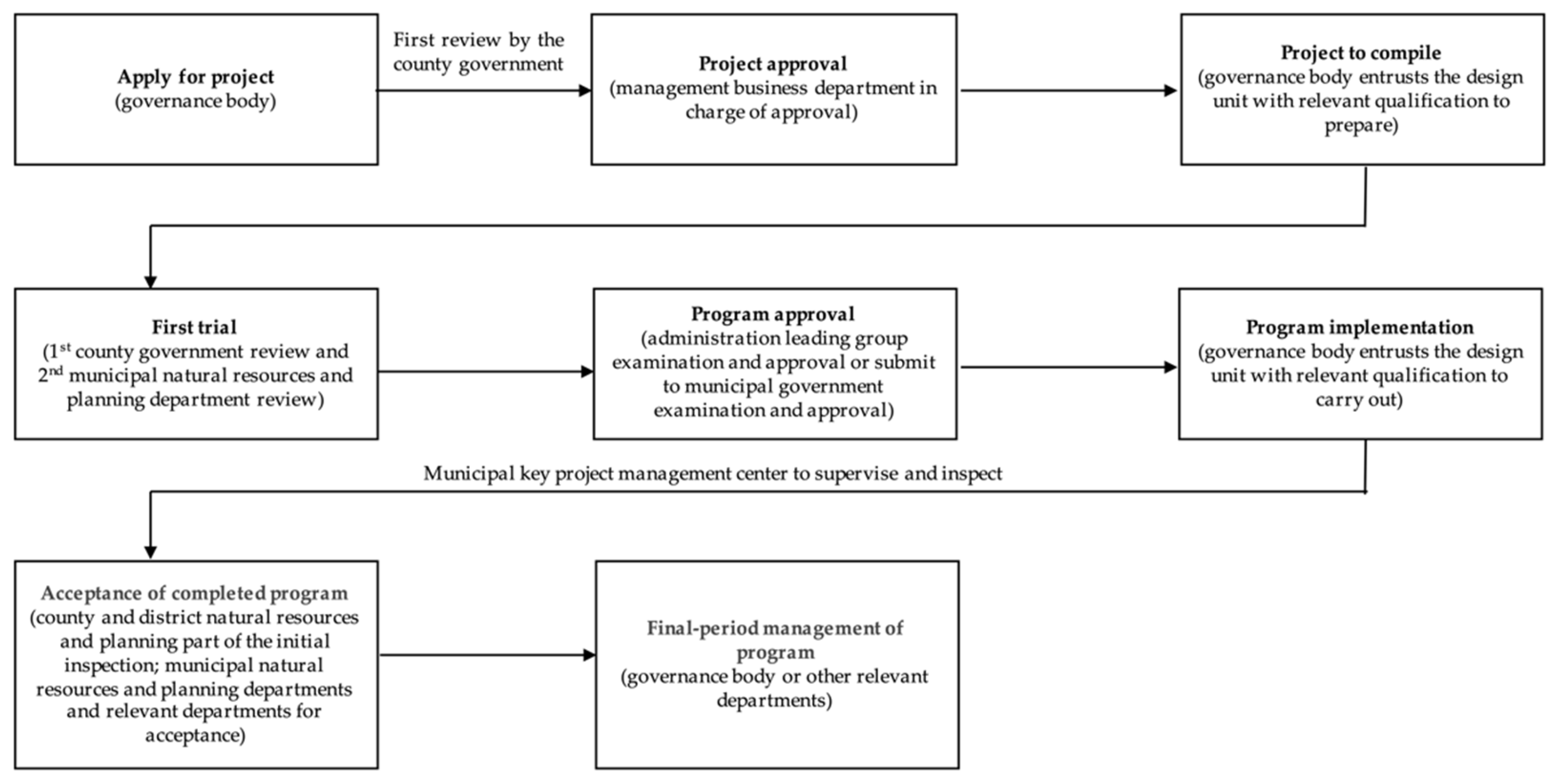
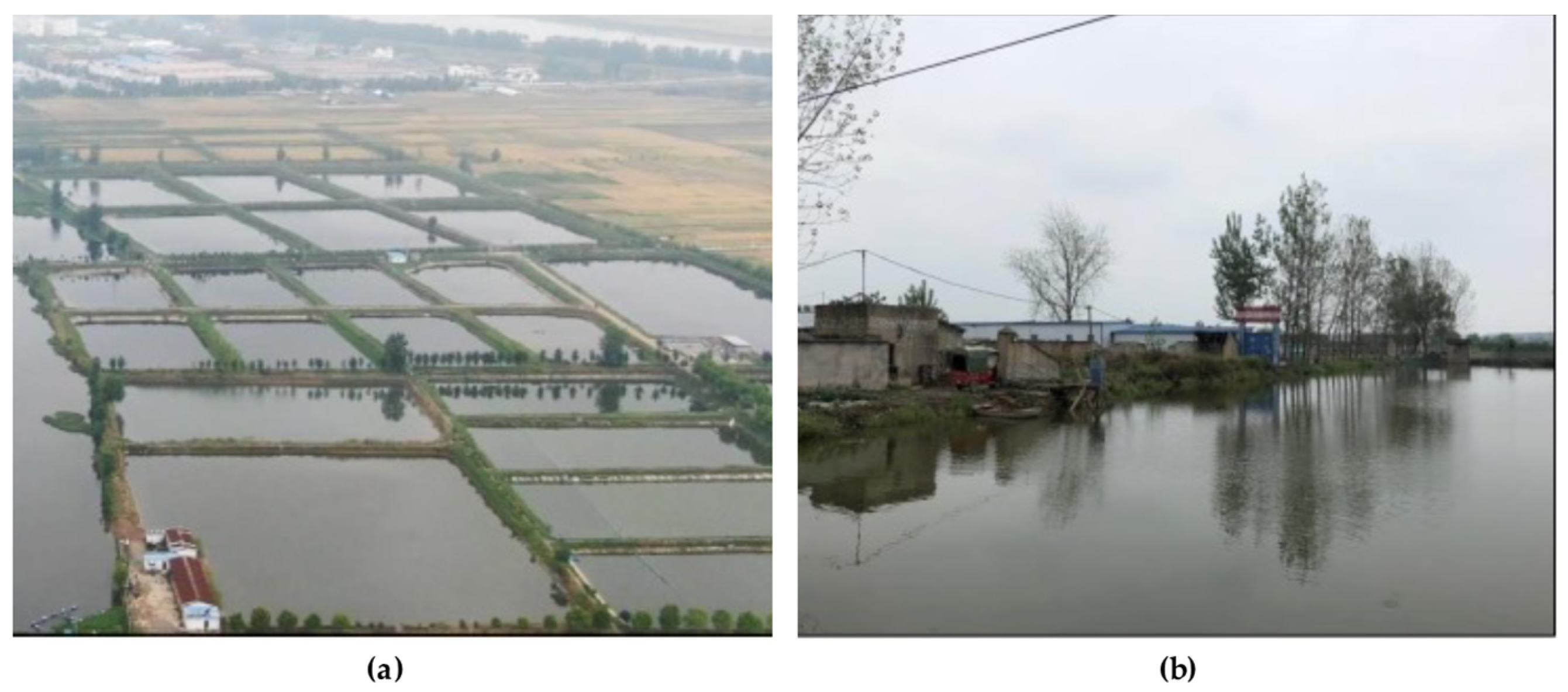
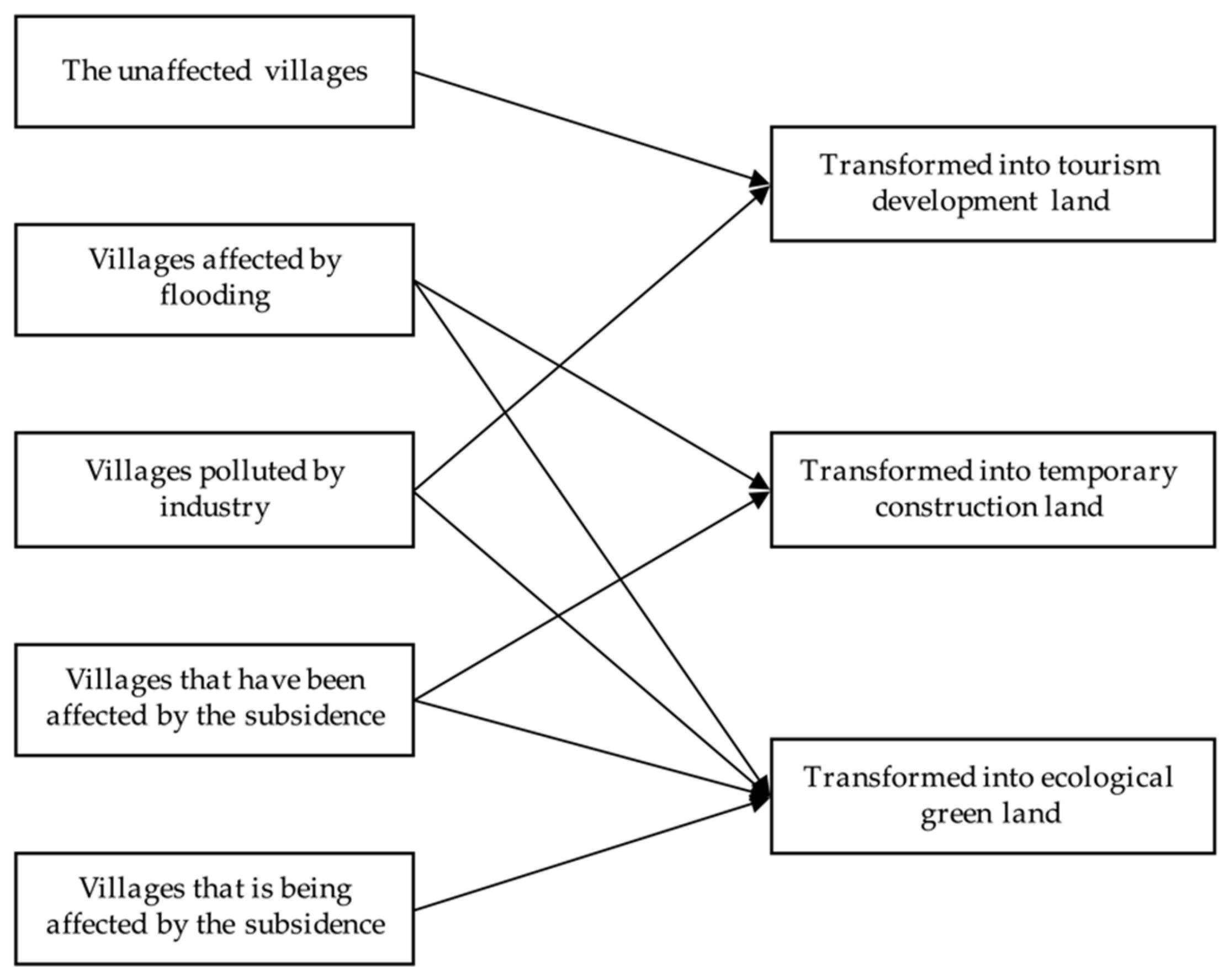
| Type | Category | Actor |
|---|---|---|
| Human actors | Individual | Mining area residents |
| Organization/Group | Municipal leadership group for ecological treatment of coal mining subsidence areas; coal mining enterprises; news media; industry associations and other social organizations | |
| Non-human actors | Traditional pattern | Natural environment; ecological subsidy; mining management policies and related policies |
| New pattern | Weibo; WeChat, Circle of Friends, BBS, and other network platforms |
| No. | Project Name | Details |
|---|---|---|
| 1 | Rural toilets and waste resources utilization |
|
| 2 | Promotion of employment and entrepreneurship |
|
| 3 | Skills training and upgrading |
|
| 4 | Minimum living allowance for rural residents |
|
| 5 | Basic medical insurance for urban and rural residents |
|
| 6 | Shantytowns transformation & Renovation of old residential areas |
|
Publisher’s Note: MDPI stays neutral with regard to jurisdictional claims in published maps and institutional affiliations. |
© 2022 by the authors. Licensee MDPI, Basel, Switzerland. This article is an open access article distributed under the terms and conditions of the Creative Commons Attribution (CC BY) license (https://creativecommons.org/licenses/by/4.0/).
Share and Cite
Wang, H.; Huang, Q.; Chen, C. Ecological Management and Land Rehabilitation in Mining Areas from the Perspective of Actor-Network Theory—A Case Study of Lizuizi Coal Mine in China. Land 2022, 11, 2128. https://doi.org/10.3390/land11122128
Wang H, Huang Q, Chen C. Ecological Management and Land Rehabilitation in Mining Areas from the Perspective of Actor-Network Theory—A Case Study of Lizuizi Coal Mine in China. Land. 2022; 11(12):2128. https://doi.org/10.3390/land11122128
Chicago/Turabian StyleWang, Huizhu, Qiang Huang, and Chao Chen. 2022. "Ecological Management and Land Rehabilitation in Mining Areas from the Perspective of Actor-Network Theory—A Case Study of Lizuizi Coal Mine in China" Land 11, no. 12: 2128. https://doi.org/10.3390/land11122128
APA StyleWang, H., Huang, Q., & Chen, C. (2022). Ecological Management and Land Rehabilitation in Mining Areas from the Perspective of Actor-Network Theory—A Case Study of Lizuizi Coal Mine in China. Land, 11(12), 2128. https://doi.org/10.3390/land11122128







